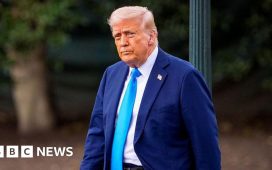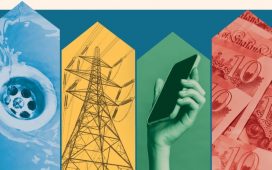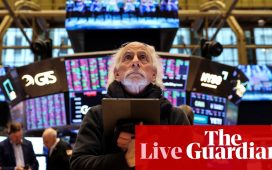The global economy is fragmenting and a new era of protectionism has dawned. Dreams by free marketeers of a frictionless world in which goods and services moved seamlessly from country to country are dead.
That was the clear message from Joe Biden’s decision last week to target China with a range of new, much higher tariffs on electric vehicles and a range of other products crucial to sectors seen by the White House as vital to the future health of the US economy and to national security.
It was also the message from Vladimir Putin’s visit to Beijing, where he received a show of support from Xi Jinping for Russia’s military action against Ukraine, which has intensified in recent weeks. There is a new cold war and it is hotting up.
In themselves, Biden’s new tariffs won’t have much economic impact, because China exports very little steel and aluminium, and few EVs, silicon chips and solar panels to the US anyway.
But as the consultancy Capital Economics has pointed out, that’s because of previously announced measures introduced by Donald Trump and the fear that protectionism will be ratcheted up in the future. Republicans and Democrats both support a hawkish approach to China.
The trade tension is unlikely to ease soon. Biden has made support for the green technology sector central to his plan to rebuild the US manufacturing base. The president is not prepared to see his industrial strategy undermined by a flood of cheap, and heavily subsidised, Chinese imports.
Tougher protectionist measures from the US come amid signs that Beijing has abandoned, at least for now,attempts to rebalance its growth model away from exports and towards domestic consumption. China remains a high-saving, high-investment, low-consumption economy and that inevitably means that the surplus goods churned out by its factories find their way into global markets. As China’s trade surplus grows ever bigger, protectionist sentiment in the US will become more pronounced.
This is not quite what the US and its developed-country allies envisaged when China was admitted into the World Trade Organization in 2001. Back then the feeling was that if China could make manufactured goods more cheaply than domestic producers, then that meant higher profits for western multinationals and lower prices for western consumers. There are far fewer advocates for this pure free-trade approach in Washington and Brussels today, even though the availability of cheap Chinese EVs in the US and Europe would help meet net zero goals.
In the short term, the focus will be on whether China will retaliate to Biden’s tariffs with protectionist measures of its own. Beijing has thus far seemed unwilling to get involved in a tit-for-tat trade war, but will be forced to do so if Trump wins the presidency in November and makes good on his pledge to slap a 60% tariff on all Chinese goods. For now, a full-blown trade war looks unlikely but it can’t be ruled out.
Seen from one perspective, Washington’s attempts to protect its green technology sector can be seen as evidence that the US is fighting an economic war with China that it is doomed to lose. China is growing at double the rate of the US, runs a thumping trade surplus and has cornered the market in solar panels and other green-tech products.
This, though, ignores some deep structural weaknesses in the Chinese economy, not least a worrying demographic trend that will see its working-age population shrink from one billion to 400 million by the end of the century.
Erik Britton, the managing director of the Fathom Consultancy, says it has been apparent for at least a decade that China’s growth rate is slowing and the period of rapid catch-up with the US is over, at least for now.
There is, as Britton points out, a strong correlation between economic freedom and living standards as measured by gross domestic product per head of population. Most of the countries with per-capita incomes of more than 50% of US levels are democracies, with oil producers being the exception. China is seeking to become a high per-capita income country while remaining a totalitarian state.
That’s not all. If there is further fracturing of the global economy into rival blocs then China is in a weaker position than the US. A US-led bloc is likely to be composed of many more – and richer – countries than a China-led bloc, despite attempts by Beijing to extend its influence overseas through the belt and road initiative.
The thinking behind the tough stance being adopted by the US goes as follows. First, it was a mistake to assume that China would become more liberal once it was plugged into the global economy.
Second, allowing China’s rapid industrial growth has hollowed out manufacturing in the US. Third, China’s model does not lend itself to free thinking and innovation, but instead relies on intellectual property being imported, often through unfair means, from the west. Fourth, it makes sense to make it as hard as possible for China to acquire this knowhow. Fifth, China’s aggressive use of industrial policy needs to be matched by the US.
If that all means the US becoming more interventionist and more protectionist, then so be it. In these circumstances, interventionism is justified and protectionism is good.
Biden thinks parts of the US economy are too strategically important to allow them to fall into Chinese hands and he is right about that. He also thinks the US needs to build up its own industrial strength and he is right about that too.
Other countries are watching closely, as well they might. There are clear lessons here for other western countries, including – and most especially – the UK.








